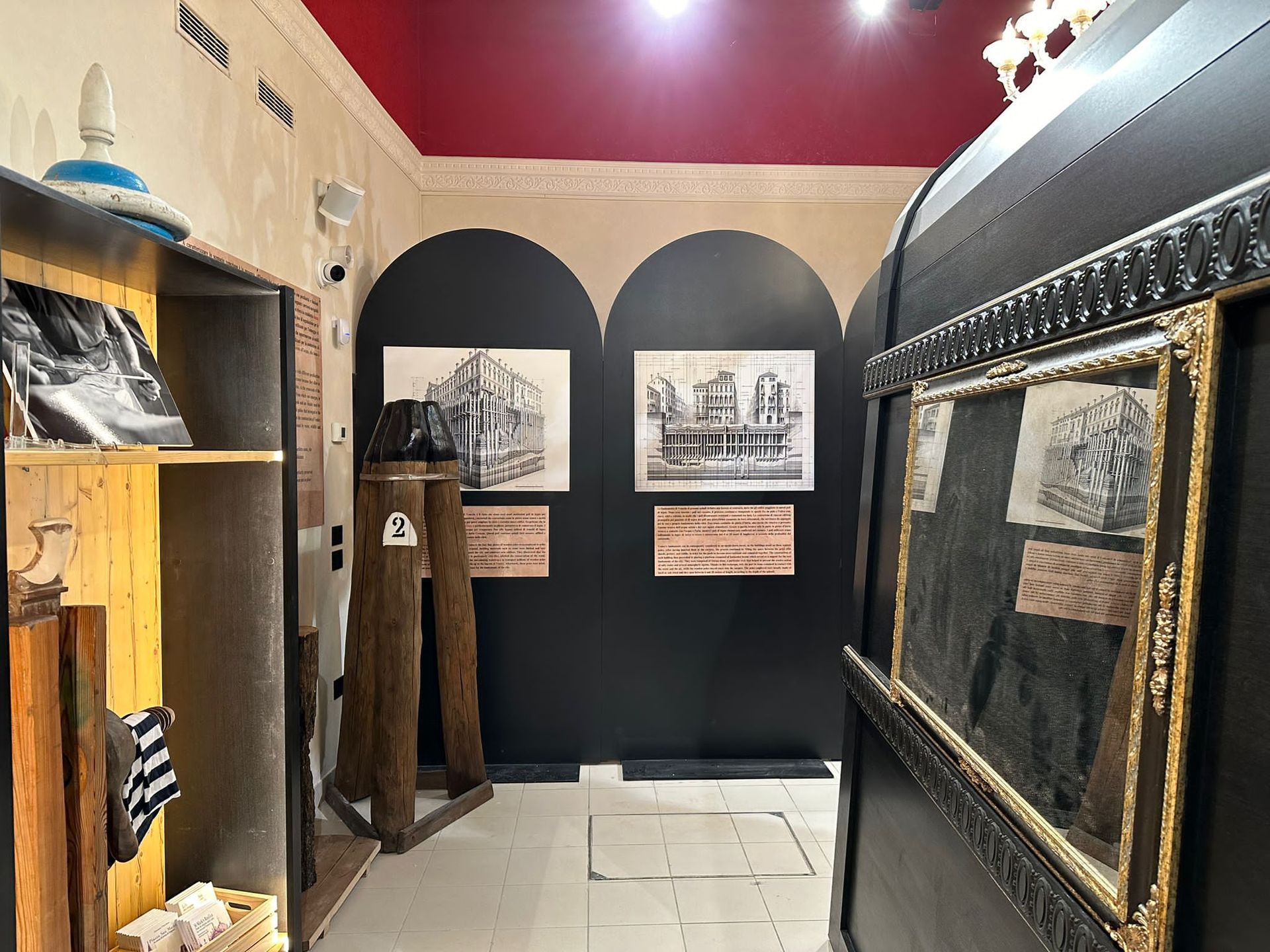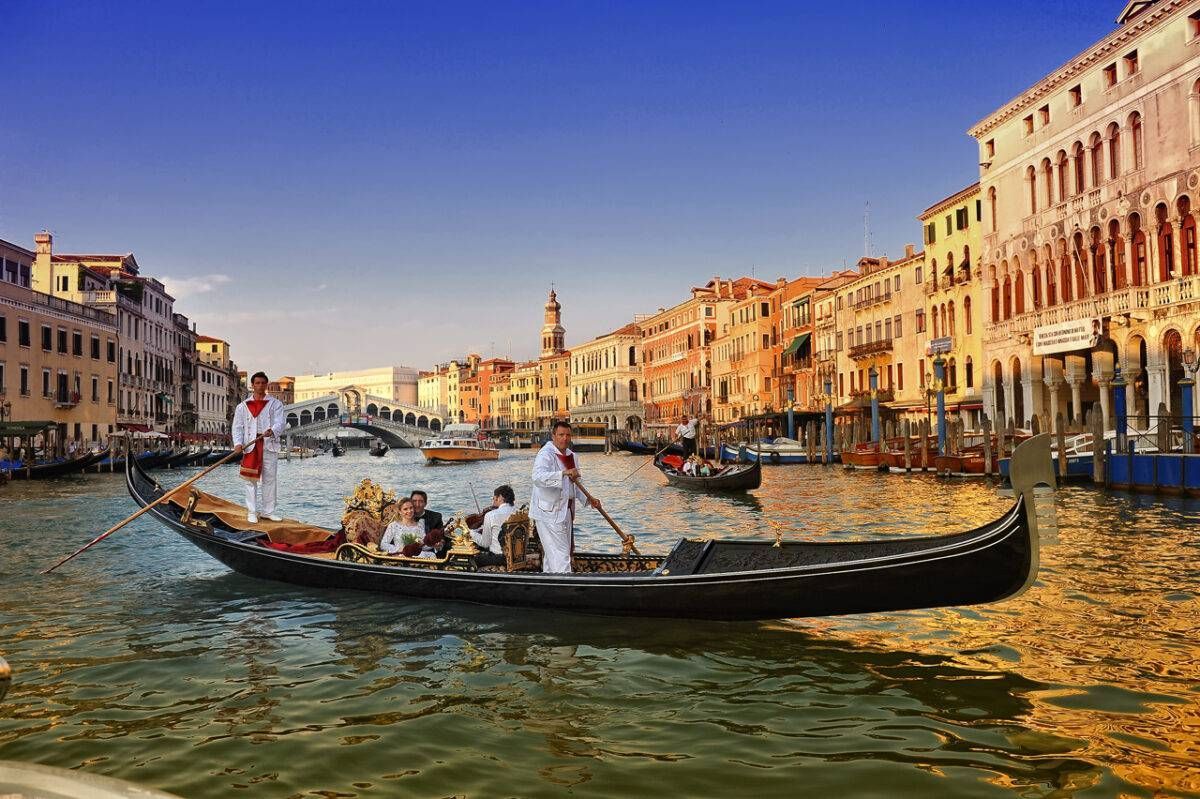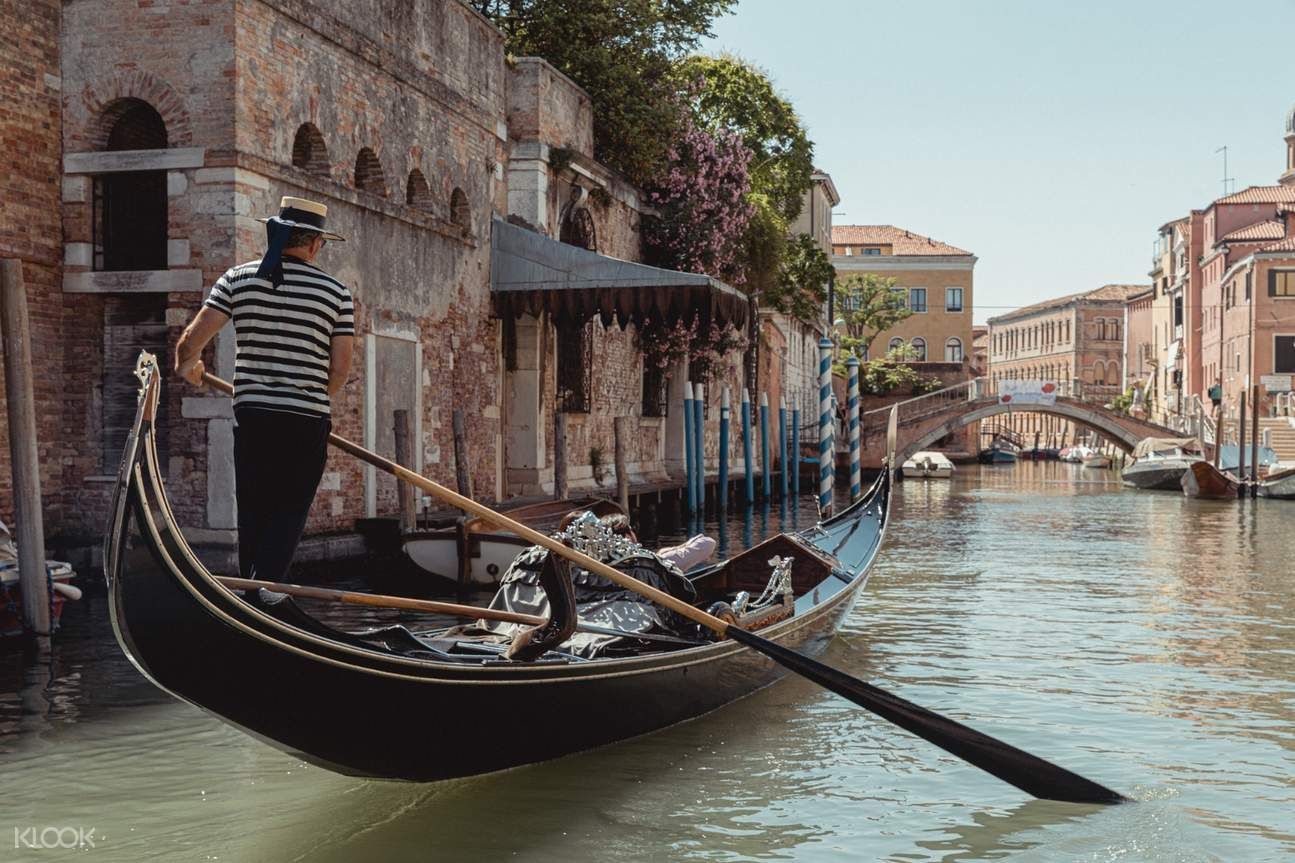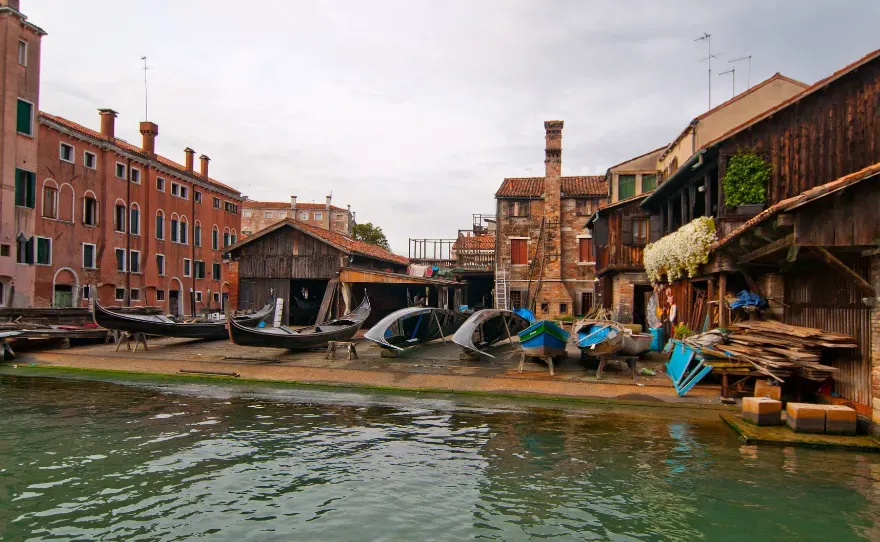Blog
Blog

May 16, 2024
The gondola is one of the most iconic symbols of Venice, a city that floats on an intricate maze of canals. This elegant and unique boat has a rich and fascinating history that dates back centuries. In this article, we will explore the evolution of the gondola and its role in Venetian culture, providing an in-depth look at this centuries-old tradition. Origins of the Gondola The origins of the gondola date back to the 11th century when Venice was a powerful maritime republic. The earliest gondolas were very different from those we know today. They were simple boats, primarily used for transporting goods and people through the city's canals. Evolution of the Design The design of the gondola has undergone numerous changes over the centuries. During the Renaissance, the gondola became a status symbol for the Venetian nobility. Wealthy families competed to have the most elaborate and decorated gondolas, often adorned with intricate carvings and precious coverings. It was during this period that the gondola took on its distinctive long and slender shape, allowing it to navigate easily through Venice's narrow canals. The Charm of the Ferro di Prua One of the most characteristic elements of the gondola is the "ferro di prua," a kind of metal comb located at the front of the boat. This ornament is not only aesthetic but also has a practical function, balancing the gondola and making it easier to maneuver. The ferro di prua is often decorated with symbols representing Venice, such as the Doge's hat and the sestieri, the six historical districts of the city. The Gondola Today Today, the gondola is primarily used for tourism. Gondoliers, with their striped shirts and straw hats, have become an icon of the city. Despite the evolution of time, the construction of gondolas remains a highly specialized craft. Each gondola is handmade using eight different types of wood, a process that can take up to a year. Visit Our Bookshop For a truly unique gondola-related experience, we invite you to visit our bookshop. Here, you can see a sectioned gondola, discover the tools used to build it, and immerse yourself in a virtual reality experience that shows you the Grand Canal through the centuries aboard a gondola. This is a not-to-be-missed opportunity to learn about the history and tradition of Venice up close. Conclusion The gondola is more than just a means of transportation; it is a living symbol of Venetian history and culture. Its timeless elegance and the craftsmanship with which it is built continue to enchant visitors from all over the world. We look forward to welcoming you to our bookshop for an unforgettable journey into the history of the gondola and Venice.

May 16, 2024
The gondola, with its timeless elegance, has been a symbol of romance in Venice for centuries. Used not only as a means of transportation but also as a central element in ceremonies and celebrations, the gondola holds a special place in the hearts of those seeking an unforgettable wedding. In this article, we will explore the history of the gondola's use in weddings, providing an in-depth look at this romantic and timeless tradition. Romantic Origins of the Gondola Since the Middle Ages, the gondola has been associated with special moments and important ceremonies. Venetian noble families often chose gondolas for transportation during weddings, considering them symbols of elegance and prestige. Gondolas adorned with flowers and precious drapes were a distinctive feature of aristocratic weddings. Weddings in Gondolas During the Renaissance During the Renaissance, the gondola became even more central to wedding celebrations. Gondolas were richly decorated and often accompanied by other boats in processions along the canals. Weddings in gondolas represented the union of two important families and were celebrated with great pomp and circumstance. The bride and groom would sail along the Grand Canal, offering an unforgettable spectacle to residents and visitors. The Gondola in Modern Weddings Even today, the gondola maintains its romantic charm and continues to be a popular choice for weddings in Venice. Getting married in a gondola is a unique experience that combines tradition and romance. Couples can choose to celebrate their ceremony on a decorated gondola, sailing through the city's historic canals. This type of wedding offers a unique and evocative perspective of Venice, creating unforgettable memories. An Exclusive Experience at Our Bookshop For those who wish to delve deeper into the history and tradition of gondola weddings, our bookshop offers an exclusive experience. Visit us to see a sectioned gondola, discover the tools used to build it, and immerse yourself in a virtual reality experience that shows you the Grand Canal through the centuries aboard a gondola. This is an unmissable opportunity to fully understand the charm and history of this Venetian symbol. Conclusion The gondola, with its elegance and timeless charm, continues to be a favored choice for weddings in Venice. Whether it is a noble tradition of the past or a romantic modern ceremony, the gondola represents a deep connection to Venetian history and culture. We invite you to visit our bookshop to learn more about the magic of gondola weddings and experience an unforgettable journey.

May 16, 2024
Venice is a city that evokes romance and magic, and there is no better way to experience this enchanting atmosphere than by participating in a gondola serenade. But what exactly is a gondola serenade? In this article, we will explore this unique experience, offering a detailed overview of what to expect and why it is a must-do activity for anyone visiting the Serenissima. What is a Gondola Serenade? A gondola serenade is a romantic experience that combines a gondola ride with a live musical performance. During the serenade, a musician, often accompanied by a singer, performs traditional Italian songs as the gondola gently glides through Venice's picturesque canals. This type of tour offers a unique and evocative perspective of the city, enriched by the melodies that resonate among the alleys and bridges. History of the Gondola Serenade The tradition of the Venetian serenade dates back centuries when young lovers would sing under the windows of their beloved. This tradition has evolved over time, becoming a refined art form and a popular attraction for visitors to Venice. Gondola serenades allow you to experience this ancient custom in a modern context, offering an authentic and engaging experience. What to Expect During a Gondola Serenade During a gondola serenade, you will be welcomed by an experienced gondolier who will guide you through the most charming canals of Venice. Onboard, a musician will play traditional instruments such as the accordion or mandolin, accompanied by a singer performing Italian love songs. The musical repertoire may include classics like "O Sole Mio," "Santa Lucia," and "Volare." Why Choose a Gondola Serenade Participating in a gondola serenade is a perfect way to celebrate a special occasion, such as an anniversary, a marriage proposal, or simply to enjoy a romantic moment with a loved one. The intimate atmosphere and sweet melodies create an indelible memory, making your visit to Venice even more memorable. Visit Our Bookshop for a Complete Experience For those who wish to delve deeper into the tradition of gondolas and Venetian serenades, we invite you to visit our bookshop. Here you can discover books and informative materials on the history of the gondola, see a sectioned gondola, and immerse yourself in a virtual reality experience that shows you the Grand Canal through the centuries aboard a gondola. This is an unmissable opportunity to fully understand the charm of Venice. Conclusion A gondola serenade is a romantic and unforgettable experience that captures the essence of Venice. Whether you are in the city for a romantic getaway or simply wish to enjoy a special moment, a gondola serenade offers a unique and captivating perspective of the Serenissima. We look forward to welcoming you to our bookshop to learn more about this magical Venetian tradition and to experience something truly special.

May 16, 2024
Venice, with its enchanting canals and historic architecture, has been the setting for many famous films. Among the city's most iconic elements, the gondola has played a starring role in numerous movies. In this article, we will explore some of the most famous films featuring the gondola and renowned actors, providing insight into how this Venetian boat has become a cinematic symbol. "Casanova" (2005) with Heath Ledger The film "Casanova," directed by Lasse Hallström, stars Heath Ledger as the famous Venetian seducer. The movie captures the romantic and adventurous essence of Venice, with many scenes filmed aboard gondolas along the city's picturesque canals. The gondolas become a symbol of freedom and adventure, perfectly aligning with Casanova's character. "The Tourist" (2010) with Johnny Depp and Angelina Jolie "The Tourist," directed by Florian Henckel von Donnersmarck, is a romantic thriller starring Johnny Depp and Angelina Jolie. The film fully leverages the mysterious and romantic atmosphere of Venice, featuring several iconic scenes with the two actors aboard a gondola. These scenes add a touch of glamour and intrigue, making the gondola a central element in the narrative. "Indiana Jones and the Last Crusade" (1989) with Harrison Ford In "Indiana Jones and the Last Crusade," directed by Steven Spielberg, Harrison Ford plays the intrepid archaeologist Indiana Jones. One of the most memorable scenes set in Venice shows Indiana and his friend Marcus Brody (played by Denholm Elliott) chasing a group of enemies aboard a gondola. This adventurous action sequence highlights the gondola's versatility as a mode of transport even in adrenaline-filled situations. "Moonraker" (1979) with Roger Moore James Bond, played by Roger Moore, visits Venice in "Moonraker." In this film, the gondola transforms from a simple means of transport into a high-tech vehicle with hidden gadgets typical of 007 films. The famous scene where Bond's gondola turns into a hovercraft has become a classic of spy cinema. The Gondola in Italian Films Besides international films, the gondola also plays a significant role in Italian cinema. Films like "Death in Venice" (1971) by Luchino Visconti, based on Thomas Mann's novel, use the gondola to express the melancholic and decadent beauty of the city. "Bread and Tulips" (2000) by Silvio Soldini also showcases Venice and its gondolas affectionately and realistically through the story of Rosalba (Licia Maglietta). Visit Our Bookshop For cinema enthusiasts and those interested in the history of the gondola, our bookshop offers a unique experience. Come discover books, films, and informational materials about the gondola and its role in cinema. Additionally, you can see a sectioned gondola and immerse yourself in a virtual reality experience that shows you Venice through the eyes of Hollywood and Italian cinema directors. Conclusion The gondola is more than just a means of transportation; it is a symbol of Venice that has captivated directors and actors worldwide. From romantic thrillers to action-packed adventures, the gondola has left an indelible mark on cinematic history. We invite you to visit our bookshop to learn more about how this iconic Venetian symbol has been celebrated on the big screen.

May 16, 2024
Venice is a city rich in history and traditions, and one of the most fascinating elements of its cultural heritage is the squero. But what exactly is a squero? In this article, we will explore the history, function, and importance of these ancient shipyards, which are still the heart of gondola construction today. Definition of Squero A squero is a small traditional Venetian shipyard, specializing in the construction, maintenance, and repair of gondolas and other typical lagoon boats. The term "squero" likely derives from the word "squadra," a tool used by carpenters, reflecting the importance of precision tools in the work of master boat builders. History of Squeri Squeri have a long history dating back to the Middle Ages. During this period, Venice was a maritime power, and boat building was a vital industry. Squeri were located along the canals to facilitate the launching of boats directly into the water. Each squero was managed by a family or a guild of master boat builders, who passed down their skills from generation to generation. Operation of a Squero Squeri are typically open-air structures, often with partial coverings to protect the boats and artisans from the elements. The central part of the squero is an inclined platform that allows gondolas to be easily slid into the water. Around this platform, there are areas dedicated to woodworking, painting, and decorating the gondolas. Construction Process in a Squero Building a gondola begins with selecting the wood. Artisans carefully choose different types of wood for various parts of the gondola, considering the specific properties of each type. Once the materials are selected, the assembly process begins, which requires great skill and precision. The gondolas are then painted and decorated, ready to be launched into the canals of Venice. Cultural Importance of Squeri Squeri are not just shipyards; they are also important places for preserving Venetian tradition and culture. Visiting a squero offers a unique opportunity to see the art of gondola building up close and to better understand the history and traditions of Venice. Some of the most famous squeri, such as the Squero di San Trovaso, are open to visitors and offer guided tours. Visit Our Bookshop to Learn More For those who wish to deepen their knowledge of squeri and gondola construction, we invite you to visit our bookshop. Here you can find books and informational materials on the history of squeri, see models of gondolas, and traditional tools used by Venetian artisans. Additionally, we offer virtual reality experiences that allow you to immerse yourself in the world of squeri and gondola building. Conclusion Squeri are a fundamental element of Venice's cultural heritage, representing centuries of tradition and craftsmanship. Understanding what a squero is and how it operates is essential to fully appreciating the beauty and complexity of Venetian gondolas. We invite you to visit our bookshop to learn more about these fascinating shipyards and their importance in the history of Venice.

May 16, 2024
The Venice Lagoon is a unique environment, renowned for its breathtaking beauty and ecological complexity. However, one of the most fascinating and challenging aspects of this lagoon is the phenomenon of acqua alta. In this article, we will explore the Venice Lagoon and the phenomenon of acqua alta, analyzing its causes, effects, and the solutions implemented to protect this historic city. The Venice Lagoon: A Natural Heritage The Venice Lagoon spans about 550 square kilometers and comprises an intricate system of canals, islands, barene (lands periodically submerged), and velme (shoals emerging at low tide). This environment is crucial for protecting the city from tides and storms, as well as being a habitat rich in biodiversity. The lagoon was formed thousands of years ago by the interaction of rivers and the sea, creating a delicate balance between fresh and saltwater. What is Acqua Alta? Acqua alta is a natural phenomenon that occurs when the water level in the Venice Lagoon rises above normal, causing temporary flooding in the lower parts of the city. This event is more common during autumn and winter, when a combination of factors such as astronomical tides, scirocco winds, and low atmospheric pressure contribute to the rise in water levels. Causes of Acqua Alta The main causes of acqua alta include: Astronomical Tides: The gravitational pull of the moon and the sun affects tidal levels, causing periodic variations in water levels. Scirocco Winds: Southern winds blowing from the Adriatic Sea can push large amounts of water into the lagoon, raising water levels. Atmospheric Pressure: Low atmospheric pressure can cause sea levels to rise, contributing to acqua alta. Climate Change: Rising sea levels due to global climate change are exacerbating the frequency and intensity of acqua alta. Effects of Acqua Alta Acqua alta can have significant effects on daily life and infrastructure in Venice. These effects include: Structural Damage: Frequent flooding can damage historic buildings, monuments, and other infrastructure. Disruption for Residents: Acqua alta can cause transportation disruptions and difficulties for residents and tourists moving around the city. Erosion and Salinity: Saltwater can erode building foundations and increase soil salinity, damaging vegetation. Solutions and Protective Measures To mitigate the effects of acqua alta, several solutions have been implemented: MOSE (Modulo Sperimentale Elettromeccanico) MOSE is a system of mobile barriers designed to protect Venice from flooding. When needed, the barriers are raised to isolate the lagoon from the Adriatic Sea, preventing excess water from entering. Warning and Prevention Systems Advanced monitoring and warning systems have been developed to predict and manage acqua alta. These systems provide real-time information to residents and authorities, enabling a rapid and coordinated response. Adaptation Measures Buildings and infrastructure in Venice are undergoing adaptation work to better withstand flooding. This includes waterproofing foundations and installing flood barriers. Visit Our Bookshop to Learn More For those who wish to deepen their knowledge of the Venice Lagoon and the phenomenon of acqua alta, we invite you to visit our bookshop. Here you can find books, maps, and informational materials that illustrate the history, causes, and solutions related to acqua alta. Additionally, we offer virtual reality experiences that allow you to explore the lagoon and see up close the impact of acqua alta on Venice. Conclusion The Venice Lagoon and the phenomenon of acqua alta are essential to understanding the complexity and fragility of this unique city. Protective and adaptive measures are crucial to preserving Venice for future generations. We invite you to visit our bookshop to learn more about this fascinating and important topic and to experience an educational and engaging journey.





